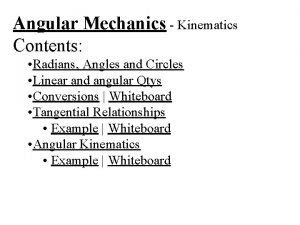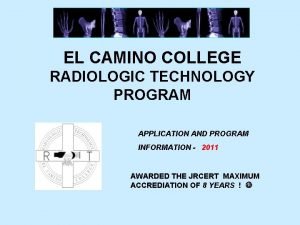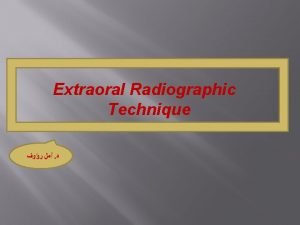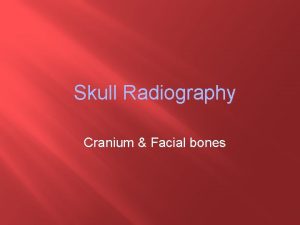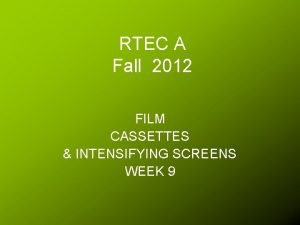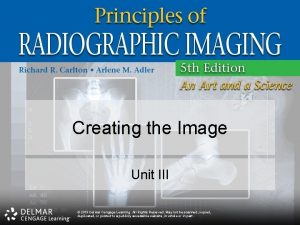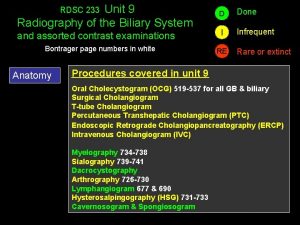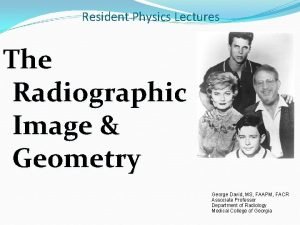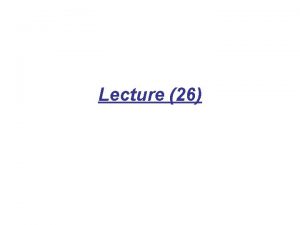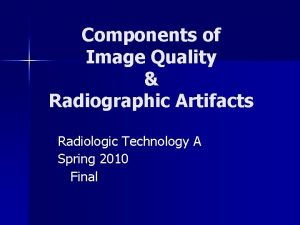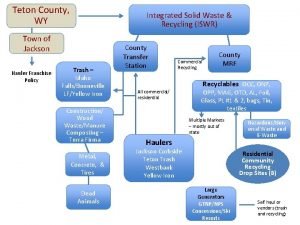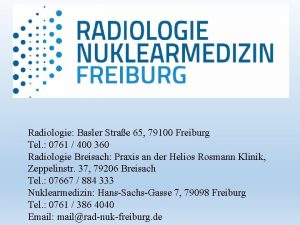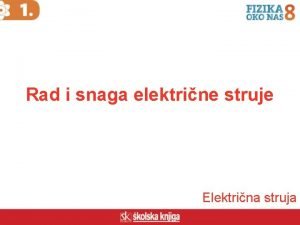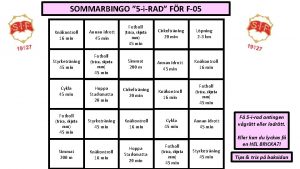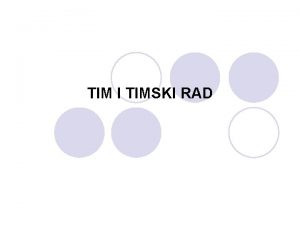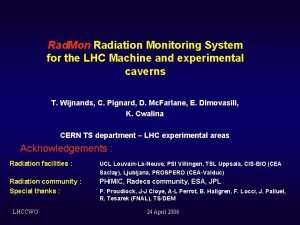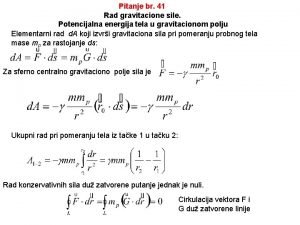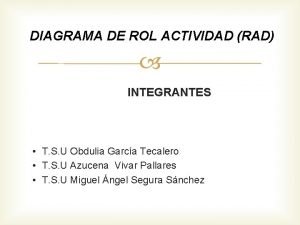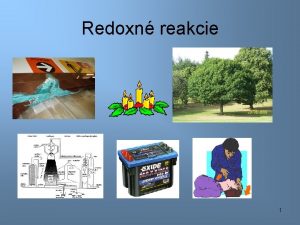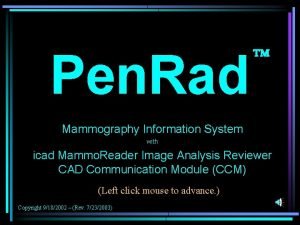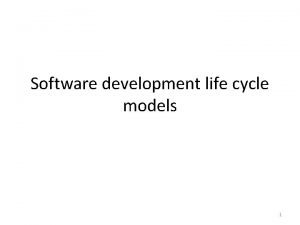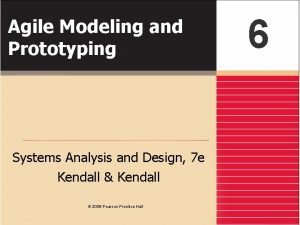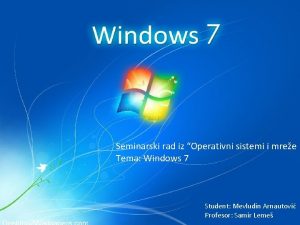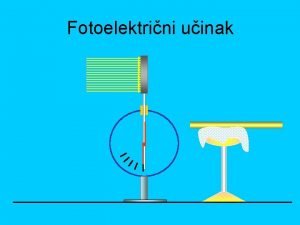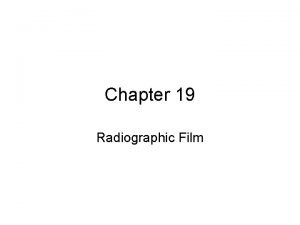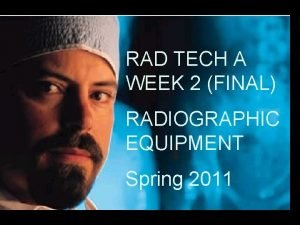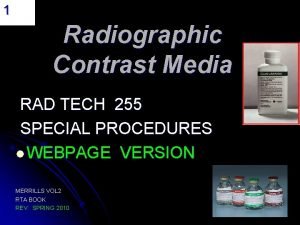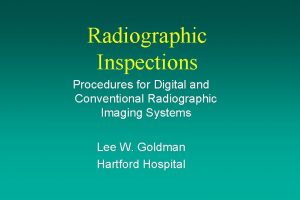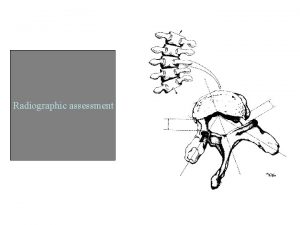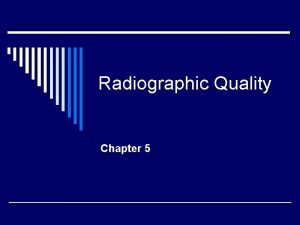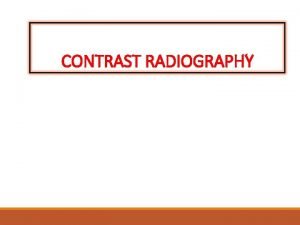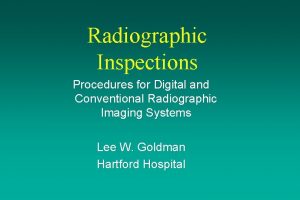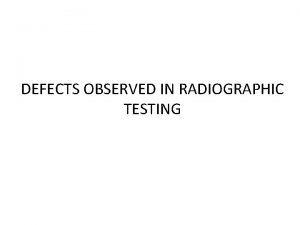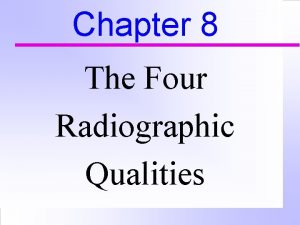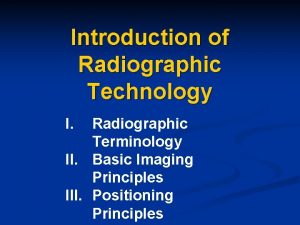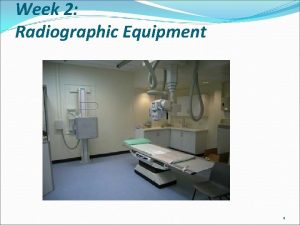RAD TECH A WEEK 2 RADIOGRAPHIC EQUIPMENT Spring



























































































- Slides: 91

RAD TECH A WEEK 2 RADIOGRAPHIC EQUIPMENT Spring 2009

RADIOGRAPHIC EQUIPMENT RTA Week 2 Ch. 8 & 9 - pg (110 & 111)

Radiographic Room

OBJECTIVES • IDENTIFY GENERIC COMPONENTS OF THE RADIOGRAPHIC EQUIPTMENT • DESCRIBE VARIOUS PLANES OF X-RAY TUBE AND TABLE MOVEMENT

A look inside the body • X-rays are a form of electromagnetic energy. X-rays have high enough energy to penetrate the human body leaving different densities on the image below • Dependant on the Z# of the material

The Electromagnetic Spectrum • X-rays have wavelengths much shorter than visible light, but longer than high energy gamma rays MEASURED IN ANGSTROM 0. 1 – 0. 5 FOR X-RAYS

THE X-RAY TUBE • The X-Ray tube is the single most important component of the radiographic system. It is the part that produces the X-rays

THE X-RAY TUBE • GLASS ENCASED IN STURDY STEEL HOUSING • PRIMARY COMPONENTS ANODE + & CATHODE --

How “X-rays” are created SEE: MAN MADE RADIATION (PG. 93) TO PRODUCE X-RAYS YOU NEED: • A SOUCE OF ELECTONS • A FORCE TO MOVE THEM QUICKLY • SOMETHING TO STOP THEM SUDDENLY

PRODUCTION OF X RAYS Requirements: – a source of fast moving electrons – must be a sudden stop of the electrons’ motion – in stopping the electron motion, kinetic energy (KE) is converted to EMS energies • Infrared (heat), light & x-ray energies

How Are X-rays Made? • X-rays are produced when electrons strike a metal target. • The electrons are released from the heated filament and accelerated by a high voltage towards the metal target. • The X-rays are produced when the electrons collide with the atoms (electrons) of the metal target.

How “X-rays” are created • Power is sent to x-ray tube via cables • m. A (milliamperage) is sent to filament on cathode side. • Filament heats up – electrons “boil off” • Negative charge

Cathode • Filament – Dual-filament • Focusing cup

Tungsten • Filaments are usually made of tungsten • Tungsten provides higher thermionic emission than other metals • Tungsten has a very high melting point



Filament • When current (m. A) is applied to the coil of wire electron are ejected • The outer-shell electrons of the filament atom are “boiled off”. – This is known as thermionic emission


Focusing cup • The filament is embedded in a metal cup that has a negative charge • Boiled off e- tend to spread out due to electrostatic repulsion. The focusing cup confines the e- cloud to a small area



How “X-rays” are created • Positive voltage (k. Vp) is applied to ANODE • Negative electrons = attracted across the tube to the positive ANODE. • Electrons “slam into” anode – suddenly stopped. • X-RAY PHOTONS ARE CREATED

Mechanical support for the target

Anodes - Target Rotating Anodes • 2” to 5” disk (focal track) • Induction motor Cu • W Speed 3000 to 10000 rpm Molybdenum or Graphite base • Common target material is Tungsten • Electrons interact with W – photons created


X-ray Production e- e- etarget e- e- e- e- eeee- e- e- e-e- e- anode electrons • electrons move at high speed (k. V) • collide with target on anode • k. V of electrons converted to x rays & heat

How “X-rays” are created • Electron beam is focused from the cathode to the anode target by the focusing cup • Electrons interact with the electrons on the tungsten atoms of target material • PHOTONS sent through the window PORT – towards the patient


TUBE HOUSING MADE OF LEAD & STEEL

XRAY TUBE HOUSING • MADE OF LEAD AND STEEL • TO ABOSRB ANY STRAY RADIATION • TO PREVENT X-RAY PHOTONS TO LEAK FROM THE TUBE


Early X-ray Tube


X-RAY TUBE • MADE OF PYREX GLASS TO WITHSTAND HIGH HEAT LOAD • IS GAS EVACUATED – (so electrons won’t collide with the air molecules in the tube)

X-ray Tube Construction A C B D E Radiographic Equipment G F

X-ray Tube Construction A. GLASS HOUSING (ENVELOPE) B. MOLYBDENUM NECK OF ANODE C. STATORS /ELECTROMAGNETS D. TUNGSTEN ANODE (FOCAL SPOT) E. WINDOW OR PORT FOR BEAM EXIT F. FILAMENT (CATHODE) G. FOCUSING CUP


X-RAY TABLE

Radiographic tables n Are designed to support the patient during a radiographic exam n Comfort is not the primary concern n Foam pads should be used if the patient will be required to be on the table for longer than 10 minutes

Tabletop Must be uniformly radiolucent to easily permit x-ray to pass through. n Carbon fiber is used because it is strong and very little x-ray photons are absorbed. n Usually tabletops are flat however some are curved n

Tabletop Most tabletops are floating, some are motor-driven n The brakes can be released usually by the technologist hand or foot n The brakes are electromagnetic n Floating table tops save significant amounts of time and strain on the technologist n

Tables • Tilting rooms are designed for both diagnostic and fluoroscopic work – Tilting models usually tilt to 90 degrees in one direction and 15 – 30 degrees in the other direction – Tilting models include ancillary equipment; footboard, shoulder support, handgrips, compression bands



FLUOROSCOPY IMAGES IN MOTION




REMOTE ROOM & OLD CONVENTIONAL FLUORO


Tube Supports • Designed to help technologists with various tube locations for creative imaging. • Tube suspension systems are available in 5 versions: – ceiling mounted, floor-to-ceiling, floor, mobile and c-arm.



Tube Movement • • • Longitudinal Transverse Vertical Angling or Rolling Rotating Telescoping

TABLE OR UPRIGHT BUCKY TRAY

The ‘BUCKY’ • The bucky is the device in the table or chest board that holds the film cassette. The ‘bucky’ is like a drawer that opens and closes to insert and remove the film cassette.


Radiographic grid & bucky tray

COLLIMATOR • ATTACHES DIRECTLY BELOW THE X-RAY TUBE • SERVES AS A X-RAY BEAM LIMITING DEVISE • CONTROLS THE SIZE AND SHAPE OF X-RAY FIELD

Cone collimator


• ALWAYS KEEP THE COLLIMATED AREA SMALLER THAN THE SIZE OF THE CASSETTE


RADIOGRAPH • PERMANENT RECORD MADE USING RADIATION – RADIO- RADIATION (usually x rays) – GRAPH PERMANENT RECORD (film)


UNEXPOSED FILM PLACED IN A CASSETTE

CASSETTE or FILM HOLDER • The CASSETTE is used to hold the film during examinations. It consist of front and back intensifying screens, and has a lead (Pb) backing. The cassette is light tight

CONTROL CONSOLE • GIVES THE TECHNOLOGIST CONTROL OF THE X -RAY MACHINE • TECHNIQUE SELECTION • Located OUTSIDE of the Radiographic Room


The Control Console • The control console is device that allows the technologist to set technical factors (m. As & k. Vp) and to make an exposure. • Only a legally licensed individual is authorized to energize the console.

“Technique” k. Vp , m. As (m. A x s) • What is set at the control panel • How the “image” is created on the “film” or Image receptor (digital) • k. Vp controls the “ENERGY” of the beam • The Higher k. Vp – more penetrating • Ranges is 50 -110 in Diagnostic x-ray

“Technique” k. Vp , m. As (m. A x s) • m. A- is the current in combination with the time – determines HOW LONG the beam will stay on • Controls the density on the film/image


Why you see what you see • The films or images have different levels of denisty – different shades of gray • X-rays show different features of the body in various shades of gray. • The gray is darkest in those areas that do not absorb X-rays well – and allow it to pass through • the images are lighter in dense areas (like bones) that absorb more of the X-rays.


IMAGES • DENSITY = THE AMOUNT OF BLACKENING “DARKNESS” ON THE RADIOGRAPH - m. As controlled • CONTRAST – THE DIFFERENCES BETWEEN THE BLACKS TO THE WHITES - k. Vp controlled

+ 30% + 50 % mas

k. Vp Changes


What is in the Darkroom?


Analog processor

Darkroom

Safe Light • 15 Watts • Red filter • Must be 3 -6 feet from counter top or feed tray of processor • Used to be amber or orange filter

Computerized Radiography CR processor • What a digital processor looks like • No darkroom required

CHEST X-RAY IS THE MOST COMMONLY Analog or Digital PERFORMED PROCEDURE


Other x-ray stuff…. • Positioning phantoms • Pixie

Other x-ray stuff…. • Positioning sponges • Lead markers • Gurney


RTA LAB 1 : EQUIPMENT • Next week…. . • TOUR OF THE IONIZING LAB HERE ON CAMPUS. • COMPLETE IN CLASS WORKSHEET FOR TERMINOLOGY
 Rad/s
Rad/s El camino college radiology program
El camino college radiology program Grid construction in radiology
Grid construction in radiology Sid and oid
Sid and oid Reverse towne projection uses
Reverse towne projection uses Radiographic darkroom layout
Radiographic darkroom layout Alveolar bone
Alveolar bone Radiographic baseline skull
Radiographic baseline skull Radiographic films
Radiographic films Dental radiographic interpretation ppt
Dental radiographic interpretation ppt Radiographic film
Radiographic film Enema positioning
Enema positioning Dacrocystogram
Dacrocystogram Geometric unsharpness of margins in radiographic image:
Geometric unsharpness of margins in radiographic image: Orbital meatal baseline
Orbital meatal baseline Emulsion pickoff artifact
Emulsion pickoff artifact Low tech and high tech assistive technology
Low tech and high tech assistive technology Med tech week
Med tech week Eti winter tech week
Eti winter tech week Week by week plans for documenting children's development
Week by week plans for documenting children's development Spring, summer, fall, winter... and spring (2003)
Spring, summer, fall, winter... and spring (2003) Spring summer winter fall
Spring summer winter fall Rad garbage driggs id
Rad garbage driggs id Rad impact
Rad impact Agile rad
Agile rad Rad iterative development
Rad iterative development Verbalna komunikacija seminarski rad
Verbalna komunikacija seminarski rad Programirana nastava
Programirana nastava Operativni sistemi seminarski rad
Operativni sistemi seminarski rad Kompozicijski dijelovi
Kompozicijski dijelovi Rad design workshop
Rad design workshop Uvod u laboratorijski rad
Uvod u laboratorijski rad Rad/fluoro qa
Rad/fluoro qa Seminarski rad
Seminarski rad Osteochondosis
Osteochondosis Pyramida právní síly
Pyramida právní síly Rad i snaga električne struje
Rad i snaga električne struje Xiv beogradska gimnazija maturski rad
Xiv beogradska gimnazija maturski rad Gonoreja slike
Gonoreja slike Rad sa darovitom decom
Rad sa darovitom decom Singidunum predmeti
Singidunum predmeti Kako napisati master rad
Kako napisati master rad Alkny
Alkny Partially circumscribed mass
Partially circumscribed mass Seminarski rad naslovna
Seminarski rad naslovna Prototyping adalah
Prototyping adalah Teme za diplomski rad informacione tehnologije
Teme za diplomski rad informacione tehnologije Etx-203ax red power light
Etx-203ax red power light Seminarski naslovna strana
Seminarski naslovna strana Sommarbingo
Sommarbingo Acr radpeer
Acr radpeer Carmen rad
Carmen rad Konzervativne sile
Konzervativne sile Tim i timski rad
Tim i timski rad Tiga kategori desain sistem
Tiga kategori desain sistem A.md rad
A.md rad Operativni sistemi seminarski rad
Operativni sistemi seminarski rad Biljke životinje i ljudi u proljeće
Biljke životinje i ljudi u proljeće Tehnološki postupci u kuharstvu
Tehnološki postupci u kuharstvu Zadnja strana maturskog rada
Zadnja strana maturskog rada Rad mon
Rad mon Socijalni rad u zdravstvu
Socijalni rad u zdravstvu Timski rad prezentacija
Timski rad prezentacija What is reactive attachment disorder
What is reactive attachment disorder Tiga kategori desain sistem
Tiga kategori desain sistem Rad gravitacione sile
Rad gravitacione sile Rol de actividades
Rol de actividades Socijalni rad s pojedincem
Socijalni rad s pojedincem Beketov rad
Beketov rad Rapid application development in software engineering
Rapid application development in software engineering Pen rad
Pen rad Rad php development
Rad php development Rad agile
Rad agile Církevní řád specializovaný na misijní činnost
Církevní řád specializovaný na misijní činnost Advantages of spiral model
Advantages of spiral model Patched-up prototype
Patched-up prototype Oslobadjanje od nocnog rada
Oslobadjanje od nocnog rada Open source rad
Open source rad Operativni sistemi seminarski rad
Operativni sistemi seminarski rad Rad etheraccess
Rad etheraccess Rad basic
Rad basic Prirodni indikatori crveni kupus
Prirodni indikatori crveni kupus Bio-rad
Bio-rad Fotoelektrični učinak formule
Fotoelektrični učinak formule Dijabetes seminarski rad
Dijabetes seminarski rad Craig chapman
Craig chapman Seminarski rad
Seminarski rad Savetodavni rad sa ucenicima
Savetodavni rad sa ucenicima Nejonizujuce zracenje seminarski rad
Nejonizujuce zracenje seminarski rad Emory healthcare virtual desktop
Emory healthcare virtual desktop Seminarski rad primer
Seminarski rad primer Rad pri sirenju gasa
Rad pri sirenju gasa
